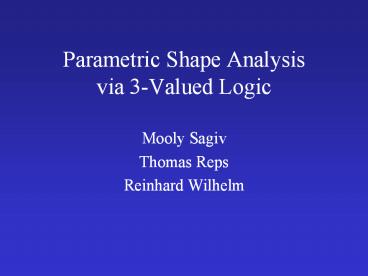Parametric Shape Analysis via 3-Valued Logic - PowerPoint PPT Presentation
Title:
Parametric Shape Analysis via 3-Valued Logic
Description:
un(u2) = 0. un(u3) = 1. Logic (Semantics) Truth values: 0, 1. Logical Structures ... u2. u3. u1. x. Logic (Semantics) Assignments. Z: free variables ... – PowerPoint PPT presentation
Number of Views:74
Avg rating:3.0/5.0
Title: Parametric Shape Analysis via 3-Valued Logic
1
Parametric Shape Analysisvia 3-Valued Logic
- Mooly Sagiv
- Thomas Reps
- Reinhard Wilhelm
2
Goals
- Capture storage invariants
- x points to a list, tree, dag, etc.
- May-alias information
- Sharing of structures
- x and y point to structures that do not share
cells - Parametric
- Framework for a collection of analyses
- Basis for an analysis-generation tool
3
The Shape-Analysis Problem
For every program point, compute a finite
characterization of the possible shapes of the
heap-allocated data structures.
4
Formalizing . . .
Informal
x
y
5
Formalizing . . .
Informal
x
y
6
Formalizing . . .
Informal
t1
x
y
t2
7
Formalizing . . .
Informal
t1
x
y
t2
Formal
t1
x
t1,x
t1,x
x
x
y
t2
t2,y
t2,y
y
y
8
Abstract Interpretation
f(a,b) (16 b 3) (2 a 1)
9
Abstract Interpretation
f(a,b) (16 b 3) (2 a 1)
O
O
O
E
O
O
E
?
E
E
?
f _ ? _ ? O
10
Abstract Interpretation
Concrete
11
Outline
- Using logic to describe stores
- Using logic to express store transformations
- Forming abstractions of stores
- Three-valued logic
- Using three-valued logic to express
transformations of abstract stores
12
Logic (Syntax)
- Vocabulary
- Predicate symbols p1, p2, . . ., pn
- Constant symbols c1, c2, . . ., cm
- Function symbols f1, f2, . . ., fk
- Formulas
- Variables
- Equality-predicate symbol
- Logical constant symbols 0, 1
- Connectives ?, ?, ?
- Quantifiers ?, ?
13
Using Logic to Describe Stores
- Predicate Symbols
- Whether variable x points to location u
- x(u)
- Pointer fields
- n(u1, u2)
- car(u1, u2)
- cdr(u1, u2)
14
Using Logic to Describe Stores
- Formulas Other Properties of Locations
un(v) ? ? v1,v2 n(v1,v) ? n(v2,v) ? v1 v2
15
Logic (Semantics)
- Truth values 0, 1
- Logical Structures
- Individuals U u1, u2, . . ., un
- Predicates ?pi ? U arity(pi) ? 0, 1
16
An Example
u1
u2
u3
Individuals U u1, u2, u3
Predicates
17
Logic (Semantics)
- Assignments
- Z free variables ? individuals
- Meaning of a formula ???(Z)
18
Meaning of a Formula
u1
u2
u3
? (v,v1,v2) n(v1,v) ? n(v2,v) ? v1 v2
Z v ? u2, v1 ? u1, v2 ? u3
???(Z) ???
19
Meaning of a Formula ???(Z)
- ?0? (Z) 0
- ?1? (Z) 1
- ?pi(v1, , vk) ?(Z) ?pi ?(Z(v1), , Z(vk))
- ??1 ? ?2?(Z) ??1 ?(Z) ? ??2?(Z)
- ??1 ? ?2?(Z) ??1 ?(Z) ? ??2?(Z)
- ??1 ? ?2?(Z) ??1 ?(Z) ? ??2?(Z)
20
Meaning of a Formula
? (v,v1,v2) n(v1,v) ? n(v2,v) ? v1 v2
Z v ? u2, v1 ? u1, v2 ? u3
???(Z) ?n(v1,v) ? n(v2,v) ?(Z) ? ?v1 v2?(Z)
?n?(u1, u2) ? ?n?(u3, u2) ? u1 u3
1 ? 1 ? 0
0
21
Outline
- Using logic to describe stores
- Using logic to express store transformations
- Forming abstractions of stores
- Three-valued logic
- Using three-valued logic to express
transformations of abstract stores
22
Using Logic to Change Stores
x null
23
Predicate-Alteration Formulas for x null
?xx null(v) ? 0
24
Predicate-Alteration Formulas for x null
?yx null(v) ? y(v)
25
Predicate-Alteration Formulas for x null
?zx null(v) ? z(v)
26
Predicate-Alteration Formulas for x null
New
y
u1
u2
z
u3
27
Predicate-Alteration Formulas for x null
New
y
u1
u2
z
u3
?nx null(v1,v2) ? n(v1,v2)
28
Predicate-Alteration Formulas for x null
New
y
u1
u2
z
u3
29
Predicate-Alteration Formulas for x null
New
y
u1
u2
z
u3
30
Outline
- Using logic to describe stores
- Using logic to express store transformations
- Forming abstractions of stores
- Three-valued logic
- Using three-valued logic to express
transformations of abstract stores
31
Abstraction Principle
32
Abstraction Principle
un(v) ? ? v1,v2 n(v1,v) ? n(v2,v) ? v1 v2
33
Outline
- Using logic to describe stores
- Using logic to express store transformations
- Forming abstractions of stores
- Three-valued logic
- Using three-valued logic to express
transformations of abstract stores
34
Two- vs. Three-Valued Logic
35
Two- vs. Three-Valued Logic
Two-valued logic
Three-valued logic
36
Outline
- Using logic to describe stores
- Using logic to express store transformations
- Forming abstractions of stores
- Three-valued logic
- Using three-valued logic to express
transformations of abstract stores































